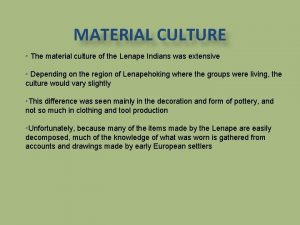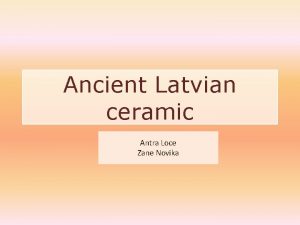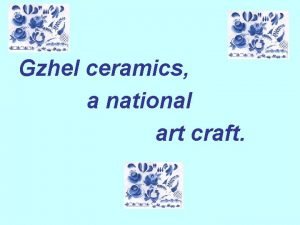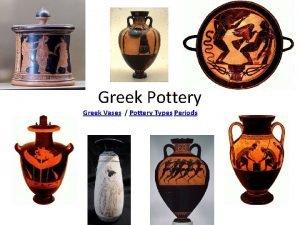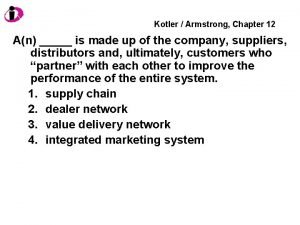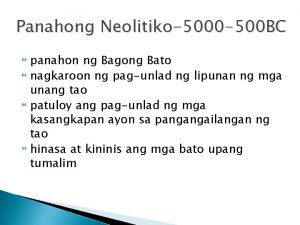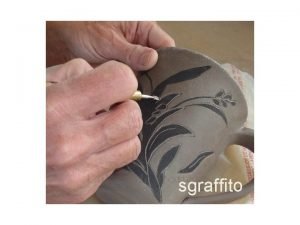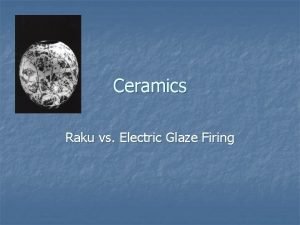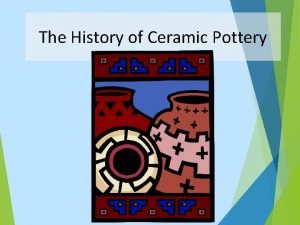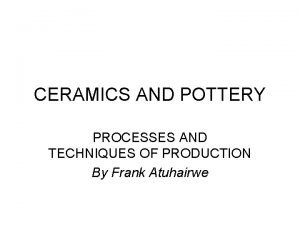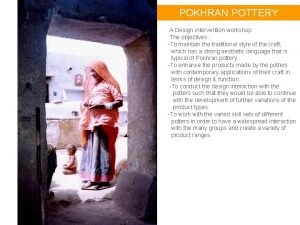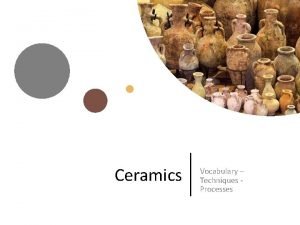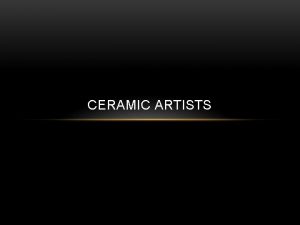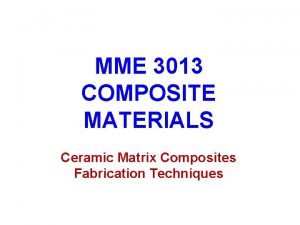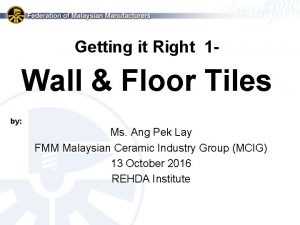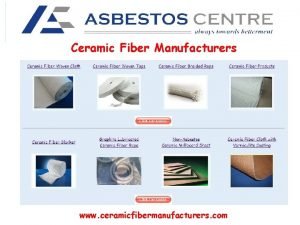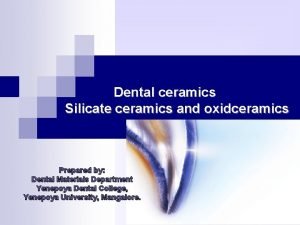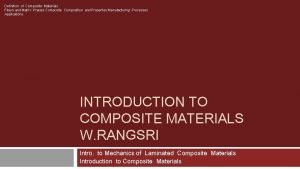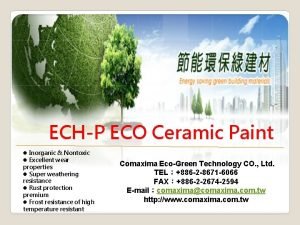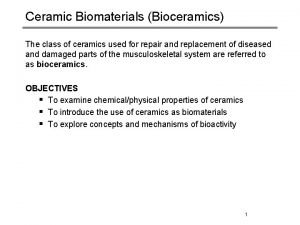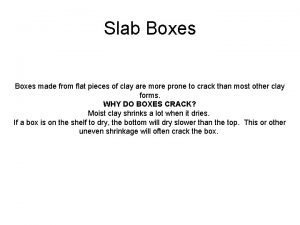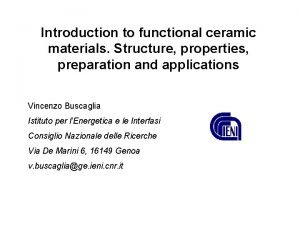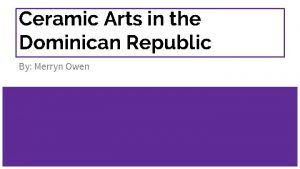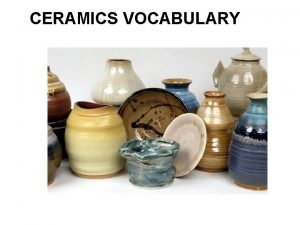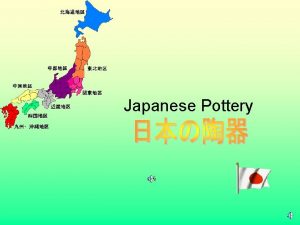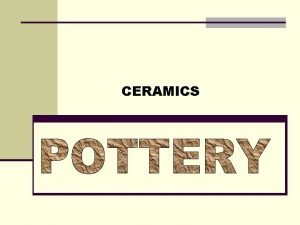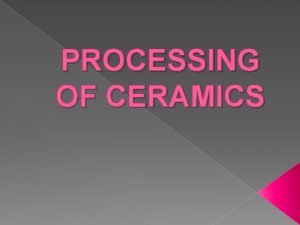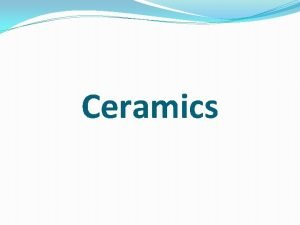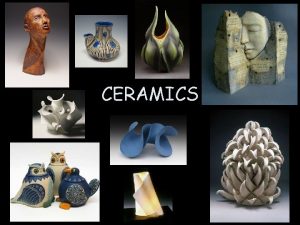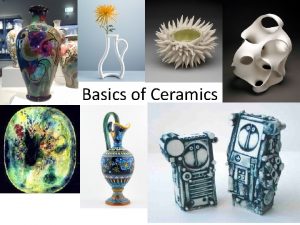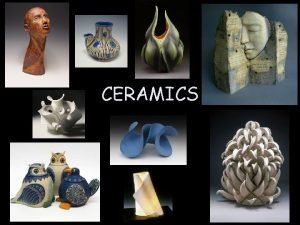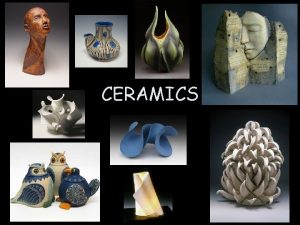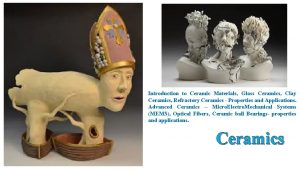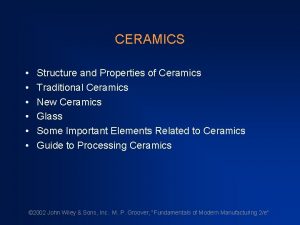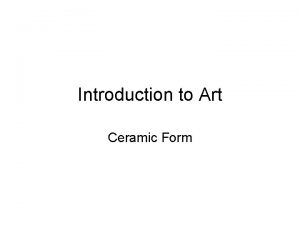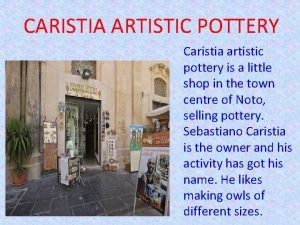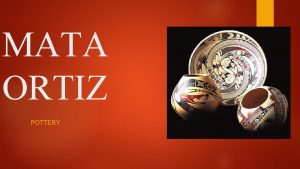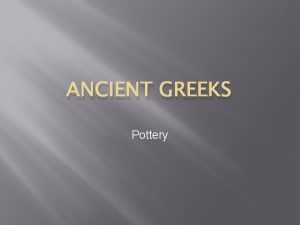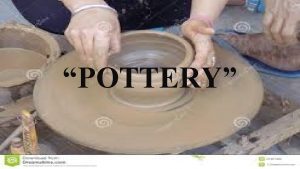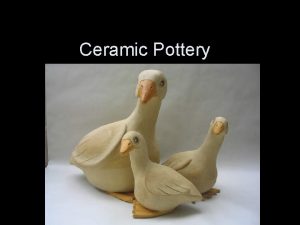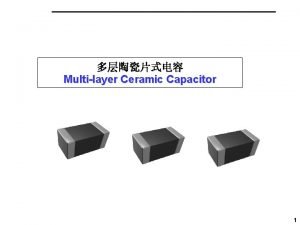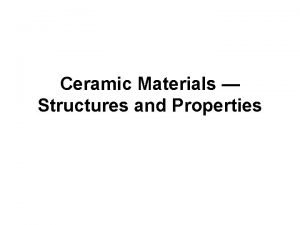Ceramics Art Ceramics Pottery Ceramics A Ceramic is































- Slides: 31

Ceramics Art

Ceramics Pottery Ceramics: A Ceramic is an inorganic compound , non metallic, solid materials like metal. Ceramic materials are brittle , hard , strong in compression. Clay objects that permanently retain their shape after they have been heating to specific temperatures and should be non-porous.

Pottery : Pottery is the ceramic material which makes up pottery wares, of which major types include earthenware, stoneware and porcelain. Pottery is one of the oldest human inventions, originating before the Neolithic period.

Production Pottery : Make large quantities of ceramic wares like plates, platters, dishes, bowls, etc. Throwing the same form of clay for all products. link: • https: //www. youtube. com/watch? v=s 7 oyv. D_a 7 Xs • https: //www. youtube. com/watch? v=_Rel 1 j 4 Zx. Pc&t=247 s Studio pottery: Studio pottery is produced by individual craftsman and proves diverse. link: • https: //www. youtube. com/watch? v=rz. NCew 3 V 6 CA • https: //www. youtube. com/watch? v=CLDqxo. R 8 u. E 8

Clay : Clay is a natural material that can be found everywhere and is formed through decomposition of igneous rocks, mainly granite. This process is called weathering. The particles that make up clay are called clay particle and are the most finegrained weathering and erosion product. Types of clay: • Primary clay • Secondary clay Clay can be divided into two geological categories: Primary clay and Secondary clay Primary clay: Primary clays are found where they were formed by the parent rock. They contain Kaolin, very pure clay. It is less plastic than secondary clay. China clay is a primary clay.

Secondary clay: The particle size of secondary clay is much finer than primary clay. It can very vastly in colour, from yellow, red, or gray to almost black. Except china clay all other clays are secondary clay. Plasticity: Clay is plastic when it can be easily manipulated molded or pressed into a desired shape. Kneading/Wedging: There are several different techniques to use when kneading clay, but in general you knead it the same way as you would knead dough for baking. More importantly, you need to remove air bubbles (air pocket) from the clay and make sure that new air is not trapped inside. Link: https: //www. youtube. com/watch? v=vj 6 Kd 8 RSm. V Y https: //www. youtube. com/watch? v=KOa. Ru. F 0 K-cc

Slip: A fluid suspension of clay in water used in joining clay pieces and for surface decoration. Major types of clay in ceramics pottery…… • Earthenware • Stoneware • Porcelain Earthenware: Earthenware clay is low-temperature clay and firing range between 900 -1050 Degree Celsius. If you fire earthen ware at high temperature the object will break & in a worst case scenario the object will melt in the oven. There are large quantities of earthenware clay around the world. The color ranges from gray or white to red, orange, yellow and brown. Earthen ware clay is porous, because the clay particles have not melted completely, & the object still absorb water, or are permeable to water, despite being fired. In order to make it strong, you need to glaze it.

Stoneware: The term ‘stoneware’ comes from the dense, hard character of the clay body. The color of stoneware varies from grayish white to gray and brown. It is compose clay & made up of different types of clay and stone dust. It has a temperature range between 1200 -1250 degree Celsius. Clay component of stoneware: 1 -China Clay 2 -Fire Clay 3 -Feldspar 4 -Silica 5 - Grog 6 -Ball Clay 7 -Earthenwar

Porcelain: The word ‘Porcelain’ is said to have evolved from “Porcellno”. Porcelain clay is white in color and is very hard & dense. It consists largely of kaolin, which makes it less plastic. Most porcelain masses tend to shrink a lot. Porcelain clay can be fired at temperatures between 1280 -1350 Degree Celsius. Stages of clay: 1 -Green ware • Wet stage • Leather hard • Bone dry 2 -Bisque 3 -Glaze

Green ware: Clay that has not been fired. Wet stage: Flexible clay, Can be formed, modelled, pinched, rolledd into slabs or coils at this stage. Wet stage Leather hard: Second stage, Clay is stiff, but workable. Best stage to join slabs, carve and burnish(smooth using plastic or hard smooth surface. Leather hard Bone dry: All water has evaporated from work. Very fragile at this point. And ready to be fired. Bone dry

Bisque firing: Bisque firing is the very first firing process. It is done when the clay is completely dry and dose not feel cold to the touch. At this stage the object, the object are very frail. Use both hand when lifting the unfired objects. Do not lift any objects by their handles. The chemical changes that take place make all the water evaporate and the turns hard in structure, which facilitates the glazing process. Remember to fire the objects slowly in the beginning of the firing process. The temperature should not rise more than 100 Degree Celsius per hour up to 600 Degree Celsius. This is because there is water bound into the clay that can blow up the object if it is heated to quickly. The pick temperature of bisque is 950 to 980 Degree Celsius. You can use the same temperature when bisque firing earthenware and stoneware.

Glaze firing: Once the objects are glazed, they need to be glaze fired. During the glaze firing the glaze melts together with the clay and equal surface. Earthenware is glaze fired at temperature ranging between 900 to 1050 Degree Celsius, stone ware and porcelain at temperature ranging between 1200 to 1350 Degree Celsius. The temperature depends on the type of clay, and on the glaze composition. During glaze firing, the temperature may rise much faster than during bisque firing. Then, there is no bound water to worry about. The firing process will still take about the same time because the temperature has to rise higher. Once the final temperature is reached , keep it at that temperature for about 15 to 30 minutes. This stage is called smoothing or shocking.

Different technique of Ceramics: • • Pinching process Coiling process Slab process Throwing process Pinching: Pinching is one of the oldest methods used to shape bowls; plates or whatever dishes you might want to create. It requires no tool other than your hand. This method is best suited for smaller objects that you can easily hold in your hand. However, with practice and a lot of patience. It is possible to create larger object. Link: • https: //www. youtube. com/watch? v=A 70 d 3 gn. Oi. L 4 • https: //www. youtube. com/watch? v=ri 1 h 7 CIGS 0 g



Coiling: Coiling is a great method to use when you want to create large and complicated shapes quickly. It is a practical technique to use when working on different irregular and soft shapes. There are different techniques when you work with coiling and you can either use round or flat coils when you make small bowls or cups you should use the rounded coils. Link: • https: //www. youtube. com/watch? v=d. PNSjz. WVU 5 c • https: //www. youtube. com/watch? v=ds 2 i. SVl. TJ 78



Slab: To slab build you must roll out a piece of clay so that it has even thickness throughout. Then you score and slip the different slab pieces where you want to attach them. Coil should be rolled out and smoothed into joined corners for added support. Link: • https: //www. youtube. com/watch? v=BJ-f. Yw 6 E 9 -4 • https: //www. youtube. com/watch? v=nplyx. Ee. Hcls&list=PLXc. FZNj 7 Tfjk 8 N 1 Nqn. Rhc. CI 5 x. Ehi. KYL



Throwing: Throwing involves cantering a ball of clay on a table that is turned by kicking a weight wheel, or operating a treadle. The form is shaped by the potters hand but is perfectly symmetrical, because of the turning of the wheel as he shapes the clay. The potter’s wheel and the wood lathe in fact operate on the same principal. Throwing is the method most commonly used today. Link: • https: //www. youtube. com/watch? v=Uv. Xap. CCVOd 8 • https: //www. youtube. com/watch? v=VJBq. A 6 a. AYbc




Firing: Firing is the most critical period of pottery –making for it is this heating process which changes the green ware into pot and then the applied glaze mixture into a matured glaze. Oxidation firing: The atmosphere in the kiln is critical for the outcome. In an electric kiln, It is always oxidation firing. This means that during the firing the entire firing process there is free access to oxygen in the furnace. An oxidation atmosphere is fired in a temperature up to about 900 Degree Celsius. Then the fuel is increased while the damper is clogged. That is how the reduction process begins. Kiln- Electric kiln Reduction firing: Reduction firing means that the oxidation is reduced during the firing. , and for this process you need a wood or gas-fired kiln. There you can control the flame by using damper. In order to keep the firing process progressing , even after the oxygen supply is curtailed, the flame will absorb oxygen from anything it can fined, even the oxygen bound in glaze. This means that the glaze colour will change.

For example: A copper glaze that usually turns green during oxidation firing will turn out red, and an iron glaze that turns yellow or reddish-brown during oxidation firing becomes green during the reduction firing process. Even the raw clay colour will turn out differently in an oxidizing atmosphere. Kiln: Gas and wood kiln. Other Firing : Raku firing, Black firing, Barrel firing Gas kiln

Gas kiln Wood kiln Electric kiln

Type of works: Functional: The ceramic object has a function and purpose. It is a utilitarian object designed to be primarily useful. Making functional pottery means that we are solving problems, thinking of technical challenges, like the size of the pot, the position of the handle, or the volume in a vessel. For example: Tea pots, plates , coffee mug etc.

Non-functional: clay. From the earliest examples to the modern day there have always been things made that have no function as tableware, Ceramics sculpture and ceramics mural. The non functional works are based on artistic. Title: Homage Artist: Susan Bleckner Heller Title: Cho Ceramic Bas-Relief Sculpture Artist-Chris Gryder

References: Book: Ceramics (A beginner's guide to tool and techniques) & Google Thanks………. Madan Singh www. madanceramics. com
 Lenape pottery
Lenape pottery Kumeyaay tools
Kumeyaay tools Hoplite pottery
Hoplite pottery Latvian pottery
Latvian pottery Gzhel pottery
Gzhel pottery Josh duarte pottery
Josh duarte pottery Types of greek vases
Types of greek vases Pottery barn
Pottery barn Panahon ng neolitiko o bagong bato
Panahon ng neolitiko o bagong bato Osage pottery
Osage pottery Sgraffito pottery technique
Sgraffito pottery technique Raku pottery definition
Raku pottery definition Pottery timeline
Pottery timeline Oneota pottery
Oneota pottery Sprigging ceramics definition
Sprigging ceramics definition Pokhran pottery
Pokhran pottery Harappan pottery
Harappan pottery Wedging definition ceramics
Wedging definition ceramics Favorite visual artist
Favorite visual artist Ancient african pottery
Ancient african pottery Ceramic matrix composites definition
Ceramic matrix composites definition Tile thickness
Tile thickness Ceramic fiber manufacturers
Ceramic fiber manufacturers Dental silicate ceramic
Dental silicate ceramic Definition of matrix in composite materials
Definition of matrix in composite materials Drift current and diffusion current
Drift current and diffusion current Non toxic ceramic paint
Non toxic ceramic paint Ceramic biomaterials
Ceramic biomaterials Ceramic slab boxes
Ceramic slab boxes Greek beads keramos
Greek beads keramos Dominican faceless ceramic dolls
Dominican faceless ceramic dolls Ceramic processing upscaling
Ceramic processing upscaling
